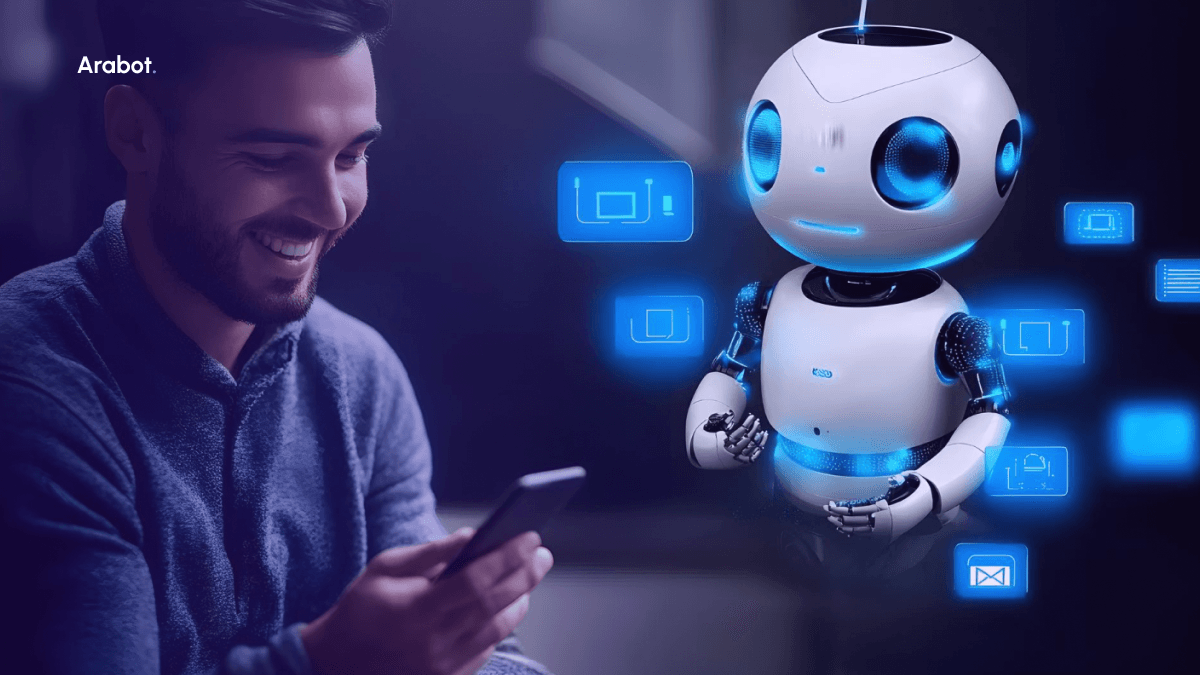- 1.
The Rise of AI Chatbots
- 2.
Understanding Consumer Preferences
- 3.
The Efficiency and Productivity Gains of AI Chatbots
- 4.
The Efficiency and Productivity Gains of AI Chatbots
- 5.
Generational Adoption: Millennials and Gen Z
- 6.
1. AI and Machine Learning Capabilities
- 7.
2. Integration with Existing Systems
- 8.
3. Voice Technology Integration
- 9.
4. Consumer Satisfaction and Business Impact
- 10.
5. Market and Industry Specifics
- 11.
Features to Look for in an AI Chatbot
- 12.
Evaluating Potential ROI and Business Impact
AI Automation
How to Choose The Right Chatbot for Your Business

AI chatbots are making big changes in business. They improve customer service and increase sales, all while being available 24/7. With the chatbot market expected to grow at a rate of 23.3% from 2023 to 2030, reaching $15.5 billion (Grand View Research), it's clear why more companies are adopting this technology to cut costs and enhance service.
This blog post is a guide for businesses on choosing the right AI chatbot. The right chatbot can significantly impact customer satisfaction and efficiency. From handling customer queries to boosting sales and supporting your team, selecting the right chatbot is crucial. With 90% of businesses reporting faster complaint resolution with chatbots (MIT Technology Review), making the right choice has never been more important. Let's explore how to select the best chatbot for your business.
The Rise of AI Chatbots
The AI chatbot market is on a steep upward trajectory. 90% of businesses have observed faster complaint resolution since their integration (MIT Technology Review). This efficiency not only improves customer satisfaction by providing faster responses but also underscores the operational benefits of chatbots in streamlining service processes.
In today's digital-first world, customers seek instant solutions. The demand for 24/7 customer service has skyrocketed, pushing operational efficiency to the forefront of business priorities. Chatbots step in as the perfect solution, offering round-the-clock service, thereby significantly enhancing customer experience and operational agility.
Moreover, with artificial intelligence automating up to 73% of healthcare admin tasks as of 2023 (Business Insider), it's clear the efficiency brought by chatbots extends well beyond customer service, supporting a wide array of operational tasks. This capability to streamline processes and interact with customers anytime has made chatbots indispensable in our current business landscape, driving the market's robust growth.
Understanding Consumer Preferences
Consumer preferences have shifted significantly towards chatbot interactions, signaling a broader acceptance and trust in this technology. A notable 35% of individuals use chatbots for resolving complaints or obtaining in-depth information, underscoring the growing confidence in chatbot efficacy (Backlinko). Additionally, 74% of internet users show a preference for engaging with chatbots when seeking straightforward answers (PSFK), highlighting the value users place on efficiency and immediate response.
Real-time responses have become a critical expectation among consumers. The capacity of chatbots to provide instant feedback 24/7 aligns perfectly with this demand. This is supported by the statistic that 64% of consumers identify the 24/7 availability of chatbots as their most valued feature (The Chatbot).
The adaptability of chatbots in performing a range of tasks, from addressing queries to facilitating transactions, is also well-regarded. Post-2020, 41.3% of consumers started using digital assistants for purchases (Drift), demonstrating chatbots' expanding role beyond mere customer service functions.
These insights reveal a clear consumer inclination towards digital assistants that offer quick, reliable, and accessible interactions. Businesses that implement AI chatbots capable of delivering on these expectations can significantly improve the customer experience, leading to greater satisfaction and loyalty.
The Efficiency and Productivity Gains of AI Chatbots
AI chatbots significantly enhance efficiency and productivity by:
- Speeding up complaint resolution: Chatbots instantly process queries, reducing wait times compared to traditional services.
- Handling multiple interactions: Unlike human agents who manage one customer at a time, chatbots scale their interactions without sacrificing service quality.
- Streamlining service workflow: They categorize complaints by urgency, ensuring quick escalation for serious issues and immediate resolution for minor ones.
These capabilities make AI chatbots a crucial element in an efficient customer service framework, improving both satisfaction and productivity.
At arabot’s client, the Saudi German Hospital, patients don't have to wait or even go to the hospital to set up their medical files. They can do it from home using just the hospital's website or a WhatsApp chatbot. This not only saves time for the patients but also makes things smoother for the hospital's team.
The Efficiency and Productivity Gains of AI Chatbots
AI chatbots significantly enhance business operations by automating customer service tasks. Here are specific examples where their impact is evident:
- Instant Responses to FAQs: Chatbots instantly provide answers, reducing the need for human customer service for common inquiries.
- Automated Booking and Scheduling: Customers can schedule appointments or make reservations through chatbots, integrating seamlessly into a company’s systems.
- Order Processing Assistance: From helping customers place orders to processing payments, chatbots streamline the shopping experience.
Some key impacts of AI chatbots on efficiency and productivity include:
- Ensuring 24/7 customer support, making sure inquiries are addressed regardless of the time.
- Scaling customer service capabilities to handle numerous conversations at once, far beyond the capacity of human teams.
- Prioritizing Urgent Issues: Chatbots identify and escalate critical problems promptly, ensuring 35% of people use chatbots to resolve complaints or obtain detailed information (Backlinko).
- Gathering valuable customer insights through interactions, aiding in the continuous improvement of services and products.
By focusing on these specific automation examples and summarizing their benefits, AI chatbots are shown as essential tools for modernizing customer service and enhancing overall business productivity.
Generational Adoption: Millennials and Gen Z
Millennials and Gen Z are at the forefront of digital interaction, setting trends that shape how businesses approach customer service. Their comfort with technology, especially AI chatbots, reveals significant insights into how younger generations prefer to communicate with brands.
- Digital First: Millennials and Gen Z have grown up in a digital world. They expect fast, efficient solutions to their inquiries, making chatbots an ideal fit. A notable 60% of millennials have interacted with chatbots, valuing their immediacy and convenience (Service Bell).
- Preference for Messaging: These younger consumers favor quick, message-based interactions. Chatbots align perfectly with this preference, offering a seamless way to engage. 20% of Gen Z users prefer starting their customer service experience with a chatbot and switching to a human agent if necessary (Northone), highlighting the desire for an initial self-service option.
- 24/7 Availability: The expectation for round-the-clock service is more pronounced among these demographics. They appreciate the non-stop availability that chatbots provide, aligning with the 64% of consumers who find 24/7 service as the most helpful chatbot feature (The Chatbot).
Catering to Millennials and Gen Z is not just about meeting their current expectations but also about setting the stage for future business growth. These demographics are soon to become the largest consumer segments.
Their buying power and influence on market trends mean that businesses need to adapt to their communication preferences to stay relevant. Integrating AI chatbots that offer quick, efficient, and accessible service is a step towards securing a competitive edge in a market increasingly driven by these tech-savvy generations.
When selecting an AI chatbot for your business, several key considerations come into play to ensure you make a choice that aligns with your goals and meets consumer expectations. Here's a closer look at one of the most crucial factors:
1. AI and Machine Learning Capabilities
The core of any effective AI chatbot lies in its intelligence, driven by AI and machine learning (ML) technologies. These capabilities enable chatbots to understand, learn from, and adapt to user interactions over time, providing a more personalized and efficient service. Here’s why advanced AI is pivotal:
- Personalized Interactions: Chatbots equipped with sophisticated AI can analyze user data and previous interactions to tailor conversations to individual preferences and needs. This level of personalization enhances the customer experience, making users feel understood and valued.
- Continuous Learning: ML algorithms allow chatbots to learn from every interaction, continually improving their accuracy and effectiveness. Over time, this learning process enables chatbots to handle inquiries more efficiently, predict user needs, and even preemptively offer solutions based on historical data.
- Understanding Context: Advanced AI enables chatbots to grasp the context of conversations, ensuring responses are relevant and coherent. This capability is crucial for maintaining a natural flow of dialogue, significantly enhancing user satisfaction.
- Scalability: With AI and ML, chatbots can scale their operations to handle a growing volume of interactions without compromising the quality of service. This scalability ensures that as your business grows, your chatbot can continue to meet the needs of your customers effectively.
Choosing a chatbot with robust AI and ML capabilities is essential for businesses aiming to provide a dynamic and engaging customer service experience.
2. Integration with Existing Systems
For an AI chatbot to truly enhance your business operations, it must seamlessly integrate with your existing software and communication channels. This integration is vital for several reasons:
- Unified Customer Experience: Integration ensures that your chatbot can provide a consistent experience across all platforms. Whether a customer interacts with your business through social media, your website, or an internal CRM system, the chatbot should offer uniform service without any discrepancies in information or quality.
- Efficient Information Access: A chatbot integrated with your business systems can quickly access and retrieve necessary information. This could include customer data from a CRM, product details from an inventory management system, or support documents from a knowledge base, enabling it to provide accurate and helpful responses promptly.
- Streamlined Operations: By connecting with existing systems, chatbots can automate tasks such as scheduling appointments, updating customer records, or even initiating processes like returns or exchanges. This automation reduces manual workload, allowing your team to focus on more complex tasks and improving overall operational efficiency.
- Data Consistency: Seamless integration ensures that data collected by the chatbot is correctly synced with other business systems. This consistency is crucial for maintaining accurate customer records, tracking interactions, and leveraging data analytics to gain insights into customer behavior and preferences.
Choosing a chatbot that can easily integrate with your current business software and communication channels is not just about ensuring operational continuity; it's about leveraging technology to provide a more coherent, efficient, and personalized customer experience.
3. Voice Technology Integration
The integration of voice technology into AI chatbots is a response to the growing trend of voice search and voice-command devices. This development reflects a broader shift in consumer behavior towards more natural, hands-free interaction with technology. Here’s why incorporating voice technology into chatbots is beneficial:
- Accessibility: Voice-enabled chatbots significantly enhance accessibility, making it easier for users to interact with your services, especially when their hands are busy, or they prefer speaking over typing. This feature is particularly beneficial for users with visual impairments or other disabilities that make typing difficult.
- Convenience: Voice interactions are often faster and more intuitive than typing. Users can ask questions or issue commands in natural language, making the process more efficient and user-friendly. This convenience can improve the overall customer experience, leading to higher satisfaction rates.
- Adaptation to User Trends: With the increasing use of voice-activated devices like smart speakers and virtual assistants, consumers are becoming more accustomed to voice interactions. Integrating voice technology into chatbots ensures that businesses stay aligned with these user trends and meet customers on their preferred platforms.
- Enhanced Engagement: Voice interactions can feel more personal and engaging than text-based ones. By enabling users to speak directly to a chatbot, businesses can create a more interactive and immersive experience that mimics human conversation, fostering a stronger connection with their audience.
Incorporating voice technology into AI chatbots is not just about keeping up with the latest trends; it's about leveraging the natural, intuitive nature of voice communication to enhance user engagement, accessibility, and satisfaction. As voice search and voice-command technologies continue to evolve, businesses that integrate these capabilities into their chatbots will be better positioned to meet the changing needs and preferences of their customers.
4. Consumer Satisfaction and Business Impact
The integration of AI chatbots into business operations has a measurable impact on consumer satisfaction, conversion rates, and sales. These digital assistants not only streamline customer service but also significantly influence purchasing decisions. Here’s a look at how chatbots are making a difference:
- Enhanced Consumer Satisfaction: AI chatbots offer immediate responses to customer inquiries, available 24/7. This constant availability meets the modern consumer's expectation for quick and efficient service. For instance, 74% of users prefer engaging with chatbots for quick answers to simple questions (PSFK), showcasing the role of chatbots in enhancing customer satisfaction.
- Improved Conversion Rates: By providing timely assistance and relevant product recommendations, chatbots can guide customers through the sales funnel more effectively. The personalized shopping experience offered by AI chatbots has been known to increase conversion rates significantly, with some industries witnessing conversion rates as high as 70% (Source provided). This demonstrates the direct impact of chatbots on driving sales.
- Sales Increases: The ability of chatbots to handle inquiries and transactions at any time contributes to an uptick in sales. Businesses have reported a 67% increase in sales through the assistance of chatbots, highlighting the substantial role they play in not just supporting but actively boosting business revenue.
- Customer Loyalty: Satisfied customers are more likely to return. Chatbots contribute to building customer loyalty by ensuring a positive, seamless service experience. The efficiency and personalized attention provided by chatbots can turn one-time buyers into repeat customers, fostering long-term relationships.
These statistics underscore the tangible benefits of AI chatbots beyond just operational efficiency. AI chatbots have become indispensable tools for businesses looking to thrive in the digital age by significantly enhancing consumer satisfaction, driving conversions, and boosting sales. Their impact on both consumer experiences and business outcomes highlights the importance of selecting a chatbot solution that aligns with your company's specific needs and goals.
5. Market and Industry Specifics
AI chatbots are making significant impacts across various industries, each leveraging their capabilities for distinct advantages:
- E-commerce and Retail: Chatbots drive sales and customer retention by providing instant support, seamless transactions, and personalized recommendations.
- Healthcare: They streamline patient care through appointment scheduling, triage, and health advice, improving patient engagement and operational efficiency.
- Banking and Finance: Chatbots enhance customer service with secure account management, transaction processing, and fraud alerts, boosting satisfaction and efficiency.
- Travel and Hospitality: Used for bookings, travel information, and customer service, chatbots increase booking rates and enhance customer loyalty with quick, personalized interactions.
- Education: In education, chatbots support tutoring, administration, and course navigation, facilitating better access to information and improving learning experiences.
Choosing a chatbot that aligns with your industry's specific needs can ensure it effectively addresses your unique challenges and opportunities.
Features to Look for in an AI Chatbot
Selecting an AI chatbot for your business involves more than just picking the most popular option. To truly enhance your operations and customer experience, focus on chatbots equipped with features that meet your specific needs.
Here are some essentials you need to keep in mind:
- Multilingual Support: Expands your reach by catering to a diverse global audience.
- Sentiment Analysis: Detects customer mood, enhancing response relevance and empathy.
- 24/7 Availability: Ensures constant support, meeting the 64% of users who value round-the-clock availability (The Chatbot).
- Personalization: Remembers user preferences for tailored interactions, boosting loyalty.
- Seamless Integration: Works with existing business systems for efficient information access and task automation.
- Analytics and Reporting: Offers insights into customer interactions for continuous improvement.
- Scalability: Easily adjusts to your growing customer service demands.
By focusing on these features, businesses can choose an AI chatbot that meets current needs and is equipped to adapt to future challenges and opportunities.
Evaluating Potential ROI and Business Impact
Assessing the ROI and overall business impact of an AI chatbot involves analyzing key areas:
- Cost Savings: Compare operational cost reductions against chatbot implementation and maintenance expenses.
- Increased Sales: Quantify sales growth from improved conversion rates linked to chatbot interactions.
- Customer Satisfaction: Use surveys to measure changes in satisfaction and retention rates post-chatbot deployment.
- Efficiency Gains: Evaluate faster resolution times and reduced human agent workload as indicators of operational efficiency.
- Data and Insights: Analyze customer data collected by the chatbot for actionable business insights.
- Competitive Advantage: Consider the chatbot's role in enhancing customer service and providing a market edge.
This evaluation framework helps determine the chatbot's financial and strategic value to your business.
Choosing the right AI chatbot is essential for enhancing customer service and improving business operations. Throughout this guide, we've discussed key considerations such as AI capabilities, system integration, voice technology, consumer preferences, and industry-specific applications. These factors are critical for ensuring your chatbot aligns with your business objectives and meets customer expectations.
Explore how an AI chatbot can transform your customer service and sales processes. Schedule a demo with arabot to understand the potential benefits for your business.
© 2025 copyright Arabot. All rights reserved.
 Insurance
Insurance Healthcare
Healthcare Automative
Automative Hospitality
Hospitality Banking
Banking Government
Government Telecommunication
Telecommunication Education
Education Human Resources
Human Resources
